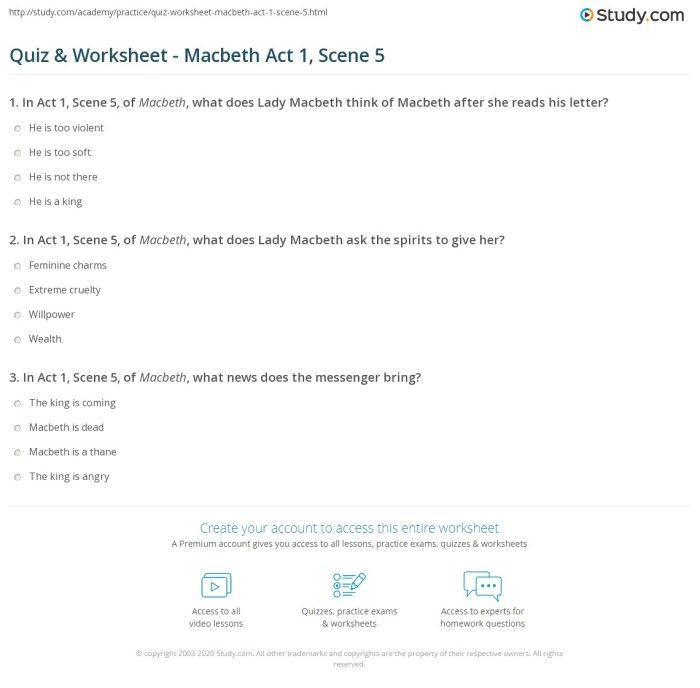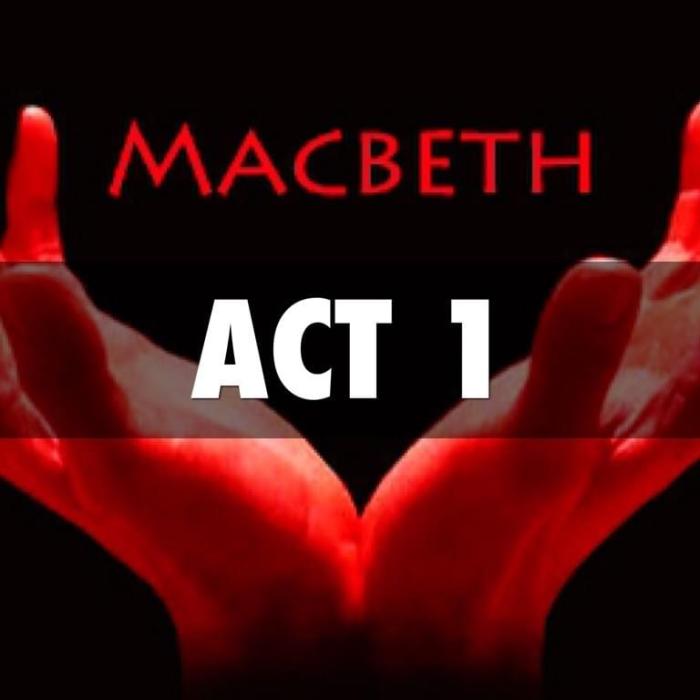Embark on a literary journey with our Act 3 Macbeth Study Guide, where the play’s pivotal events and characters unravel in captivating detail. Immerse yourself in the intricate plot, delve into the depths of Macbeth’s transformation, and unravel the profound themes that shape this timeless masterpiece.
Plot Summary: Act 3 Macbeth Study Guide

Act 3 of Macbeth marks a pivotal turning point in the play, as the witches’ prophecies continue to haunt Macbeth and Lady Macbeth, driving them further into darkness and despair.
In the opening scene, Macbeth meets with the witches once more, seeking to confirm his fate and secure his position as king. The witches deliver a series of ambiguous prophecies, including that he will not be defeated by any man “of woman born” and that he will rule until “Birnam Wood come to Dunsinane.”
These prophecies give Macbeth a false sense of security, leading him to believe that he is invincible.
The Banquet Scene
Macbeth hosts a banquet in his castle, attended by Banquo and other nobles. During the feast, the ghost of Banquo, whom Macbeth had murdered in Act 2, appears before him. Only Macbeth can see the ghost, and his horrified reaction reveals his guilt and instability.
Lady Macbeth attempts to dismiss the ghost as a hallucination, but Macbeth’s behavior becomes increasingly erratic, causing the guests to suspect that something is amiss.
Macbeth’s Descent into Tyranny
Haunted by the witches’ prophecies and the ghost of Banquo, Macbeth descends further into tyranny. He orders the murder of Macduff’s family, including his wife and children. This act of unspeakable cruelty reveals the extent to which Macbeth has become consumed by his ambition and guilt.
The Significance of the Witches’ Prophecies
The witches’ prophecies play a crucial role in shaping the plot of Act 3. Macbeth’s belief in the prophecies drives him to commit heinous crimes in order to secure his power. However, the prophecies also serve as a double-edged sword, as they ultimately lead to his downfall.
The prophecy that Macbeth will not be defeated by any man “of woman born” gives him a false sense of security. However, Macduff, who was born by caesarean section, fulfills the prophecy and kills Macbeth in the final act of the play.
The prophecy that Macbeth will rule until “Birnam Wood come to Dunsinane” also proves to be false. In the final battle, Malcolm’s army disguises itself with branches from Birnam Wood, fulfilling the prophecy and leading to Macbeth’s defeat.
Character Analysis
The central characters in Act 3, Macbeth and Lady Macbeth, undergo significant transformations. Macbeth, initially a valiant warrior, succumbs to ambition and guilt, while Lady Macbeth, driven by her desire for power, descends into madness.
Delving into the intricate complexities of Act 3 of Macbeth requires a comprehensive study guide to navigate its profound themes and characters. As you immerse yourself in the play’s dark and tumultuous world, consider exploring the GB major scale bass clef to enhance your understanding of the underlying musicality and emotional depth of the text.
Returning to Act 3 of Macbeth, the study guide will provide invaluable insights into the pivotal events that shape the play’s tragic trajectory.
Macbeth
Macbeth’s transformation is marked by a series of key moments. After the witches’ prophecy, his ambition is ignited, leading him to murder Duncan. This act breaks the moral code that once governed him, unleashing a spiral of violence and paranoia.
As Macbeth’s guilt intensifies, he experiences hallucinations and becomes increasingly isolated. He is haunted by the ghost of Banquo, whom he has murdered, and his own conscience weighs heavily upon him. Macbeth’s descent into tyranny is complete when he orders the murder of Macduff’s family, an act of cruelty that alienates him from his followers.
Lady Macbeth
Lady Macbeth’s role in Macbeth’s actions is complex. She is initially the driving force behind his ambition, encouraging him to murder Duncan. However, as the consequences of their actions unfold, Lady Macbeth’s guilt and remorse consume her.
She sleepwalks, haunted by visions of blood and guilt. Her madness intensifies until she eventually dies, unable to bear the weight of her crimes. Lady Macbeth’s descent into madness highlights the destructive power of ambition and the consequences of violating moral boundaries.
Themes and Motifs
Act 3 of Macbeth delves into the depths of human nature, exploring the destructive power of ambition and the corrosive effects of guilt. Shakespeare employs a range of motifs to convey these themes, creating a haunting and unforgettable atmosphere.
The central themes of Act 3 are intricately intertwined and mutually reinforcing. Ambition, the driving force behind Macbeth’s actions, consumes him and leads him down a path of darkness. As he succumbs to his desires, guilt gnaws at his conscience, manifesting itself in hallucinations and sleeplessness.
Motifs
Shakespeare masterfully employs several motifs to enhance the themes of Act 3:
- Blood: The play is awash in blood, both literal and metaphorical. It represents the violence and bloodshed that accompany Macbeth’s ambition, as well as the guilt that stains his soul.
- Darkness: The world of Act 3 is shrouded in darkness, both physical and psychological. It reflects the inner turmoil of Macbeth and Lady Macbeth as they grapple with the consequences of their actions.
- Sleeplessness: Macbeth and Lady Macbeth are haunted by guilt and fear, which rob them of sleep. Their inability to find respite in slumber symbolizes their descent into madness and despair.
These motifs work together to create a vivid and disturbing atmosphere, immersing the audience in the psychological torment of Macbeth and Lady Macbeth. They underscore the destructive power of ambition and the devastating consequences of evil.
Literary Devices
In Act 3, Shakespeare employs a range of literary devices to heighten the dramatic impact and explore the play’s themes. These devices include foreshadowing, irony, and symbolism, each contributing to the play’s depth and complexity.
Foreshadowing
Foreshadowing is used throughout Act 3 to hint at the tragic events to come. For example, the witches’ prophecy that Macbeth will become king is a clear foreshadowing of his eventual rise to power. Similarly, the appearance of the ghost of Banquo foreshadows Macbeth’s guilt and the consequences of his actions.
Irony
Irony is also prevalent in Act 3. For instance, Macbeth’s attempts to secure his power ultimately lead to his downfall. The irony is that he sacrifices his own morality and humanity in the pursuit of ambition, only to find that his actions bring about his own destruction.
Symbolism, Act 3 macbeth study guide
Symbolism is used extensively in Act 3 to convey deeper meanings and emotions. The witches’ cauldron, for example, represents the chaos and evil that Macbeth has unleashed upon himself. The blood on Macbeth’s hands symbolizes his guilt and the weight of his crimes.
Historical Context

Act 3 of Macbeth unfolds against the backdrop of 11th-century Scotland, a time marked by political turmoil and violent power struggles.
The play’s setting and events were heavily influenced by Shakespeare’s time and culture. The reign of Queen Elizabeth I (1558-1603) was a period of relative peace and stability, but it was also a time of religious tensions and political intrigue.
Shakespeare’s plays often reflected the anxieties and preoccupations of his contemporaries, and Macbeth is no exception.
The Scottish Witch Hunts
The play’s depiction of witches and witchcraft is rooted in the widespread belief in supernatural forces during Shakespeare’s time. In the 16th and 17th centuries, witch hunts were rampant in both England and Scotland. Thousands of people, primarily women, were accused of witchcraft and executed.
Shakespeare’s portrayal of the witches in Macbeth reflects the popular fears and beliefs of his time.
Performance Considerations
The staging and lighting design for Act 3 of Macbeth should be carefully considered to enhance the play’s atmosphere, characters, and themes.
Staging Concept
The staging should create a sense of unease and tension, reflecting the play’s themes of guilt, ambition, and madness. The set could feature sharp angles and dark colors, with a focus on verticality to emphasize the characters’ power struggles. The use of symbolic props, such as the witches’ cauldron, could further enhance the atmosphere.
Lighting Design
The lighting design should complement the staging concept, using dramatic lighting effects to highlight key moments in the play. For example, during the banquet scene, the lighting could shift from warm and inviting to cold and sinister as Macbeth’s guilt consumes him.
In the sleepwalking scene, a dim, flickering light could create an eerie and unsettling atmosphere.
Adaptations
Adaptations of Act 3 of Macbeth vary in their interpretations and conveyances of the play’s themes and characters.
For instance, Roman Polanski’s 1971 film adaptation emphasizes the play’s psychological horror and the deterioration of Macbeth’s mind. Polanski’s use of close-ups and subjective camera angles creates a sense of claustrophobia and unease, reflecting Macbeth’s descent into madness.
Film Adaptations
- Orson Welles’ 1948 adaptation focuses on the political and historical context of the play, depicting Macbeth as a ruthless tyrant rather than a tragic hero.
- Justin Kurzel’s 2015 adaptation uses stylized violence and visceral imagery to convey the play’s themes of ambition and guilt.
Theater Adaptations
- Trevor Nunn’s 1976 Royal Shakespeare Company production emphasized the supernatural elements of the play, using elaborate stagecraft and music to create a haunting and atmospheric setting.
- Kenneth Branagh’s 1988 production set the play in a fascist society, drawing parallels between Macbeth’s tyranny and the rise of dictatorships in the 20th century.
Opera Adaptations
- Giuseppe Verdi’s 1847 opera Macbeth focuses on the psychological and emotional aspects of the play, exploring the characters’ inner turmoil and motivations.
- Benjamin Britten’s 1946 opera Macbeth sets the play in a bleak and desolate landscape, using minimalist music and stark staging to convey the play’s themes of violence and despair.
General Inquiries
What is the significance of the witches’ prophecies in Act 3?
The witches’ prophecies serve as a catalyst for Macbeth’s descent into tyranny, fueling his ambition and driving him to commit heinous acts.
How does Lady Macbeth’s influence shape Macbeth’s actions?
Lady Macbeth’s relentless ambition and manipulative nature play a crucial role in Macbeth’s transformation, encouraging him to embrace his darkest impulses.
What are the central themes explored in Act 3?
Act 3 delves into the themes of ambition, guilt, the corrosive effects of evil, and the consequences of unchecked power.